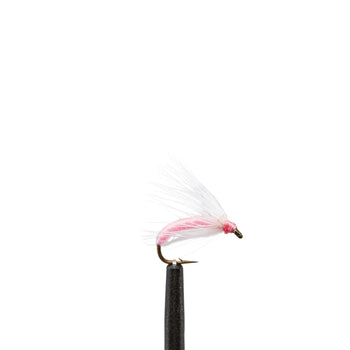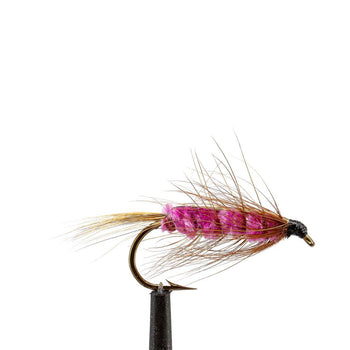Pretty in Pink: Why Pink Fly Patterns Deserve a Spot in Your Spring Fly Box

Spring can be a frustrating time on the water—cold, fluctuating flows, moody trout, and unpredictable weather all conspire to make things tricky. But one thing you can count on? Pink flies consistently produce. Whether you’re fishing pressured tailwaters or runoff-stained freestones, pink is one of those sleeper colors that grabs attention and converts refusals. It doesn’t mimic any single insect, yet it works across a surprising range of conditions.
In this month’s Fly of the Month spotlight, we dive into why pink fly patterns consistently outperform in the spring, when and where to fish them, and which patterns should absolutely make the cut in your fly box this season.
Why Pink Works in Spring
Let’s get one thing straight—pink isn’t a “natural” color in the traditional sense of matching the hatch. But trout don’t care. In spring, they’re opportunistic feeders looking for easy meals, and pink stands out just enough to pique interest without blowing them out. More than just an attractor, pink mimics a variety of high-protein food sources that become available this time of year, including eggs, scuds, sowbugs, and even drifting worms. Combine that with high water and limited visibility, and pink becomes less of a gimmick—and more of a go-to.
-
Visibility in stained water: Spring runoff turns rivers into a swirling mix of snowmelt, debris, and algae. Pink punches through turbidity better than many drab or natural shades.
-
Attractor color for lethargic fish: Cold water means slower metabolism. Subtle presentation matters, but so does a trigger color that stands out without spooking.
-
Mimics eggs, worms, and scuds: Spring is prime time for spawning rainbows and high-drift protein sources like worms and scuds. Pink does double-duty as an egg imitation and invertebrate attractor.
-
Proven in pressure: Pink flies have a long-standing reputation as confidence patterns on pressured tailwaters, where fish have grown cautious of standard naturals.

When and Where to Fish Pink Flies
While pink flies can be fished year-round, spring is where they shine the brightest. Snowmelt swells rivers, pushes debris into the water column, and dislodges all kinds of protein-rich prey into the drift. Trout may not always rise in these conditions, but they still feed—especially near spawning activity or in deeper, softer seams where food funnels through. Whether you’re drifting nymphs, swinging soft hackles, or stripping a wormy streamer, pink offers the perfect blend of visibility and trigger appeal.
-
Post-spawn rainbow feeding zones
Target riffle tailouts, inside seams, and drop-offs where trout pick off protein-rich drift. -
High, off-color spring flows
Use pink to your advantage when visibility drops below two feet. Flash, bead heads, and bright shades grab attention fast. -
Stillwaters and spring creeks
On clear lakes and low-gradient creeks, subtle pink midges, scuds, or soft hackles can outfish louder attractors. -
Anytime you need a confidence bump
If nothing else is working, tying on a pink fly is often the change-up needed to break a slump.
Top Pink Fly Patterns for Spring
There’s no single “pink fly” that works across every situation—so we’ve organized our favorites into a well-rounded system. Below you’ll find our go-to pink patterns broken down by presentation style: nymphs and jigs for sub-surface work, dries for topwater action, streamers for aggressive takes, and a few bonus patterns that do a little bit of everything. These are the confidence flies we rely on all spring long.
Pink Eggs & Worms
When trout need calories early in the season, few flies outperform the humble egg or worm. These patterns imitate high-protein food sources like spawn, annelids, and aquatic worms that get dislodged during spring runoff or show up in post-spawn feeding zones. Whether fished as anchor flies, dead-drifted through seams, or suspended under indicators, they consistently get eaten—especially when visibility drops.
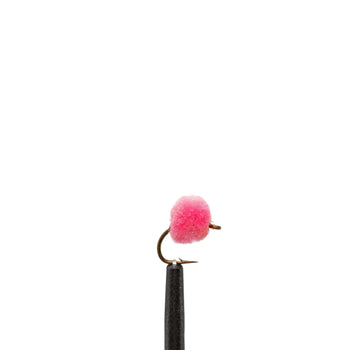
|
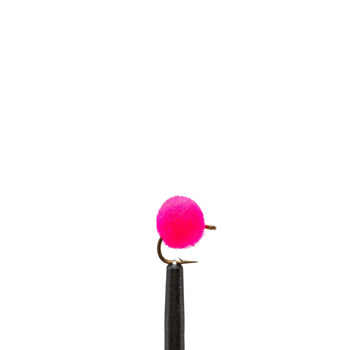
|
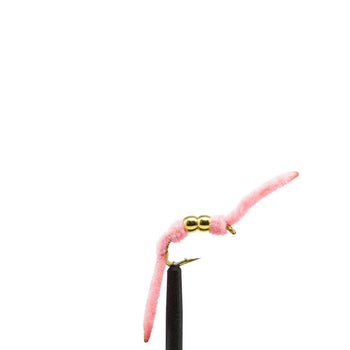
|
| Glo Bug - Pink | Glo Bug - Cherise | Double Bead Ultra Worm - Pink |
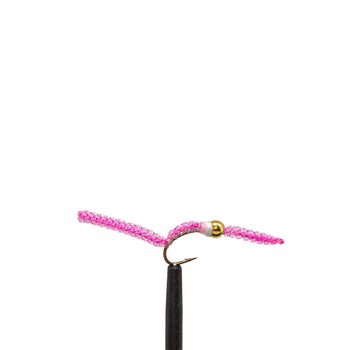
|

|
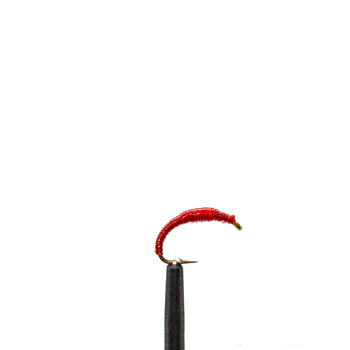
|
| Sparkle Worm - Pink | San Juan Worm | Rock Worm |
Glo Bug - Pink (size 12–16): A classic egg pattern with bright color and a natural drift. Highly effective during rainbow trout spawning periods.
- How to Fish: Drift under an indicator near spawning beds or in deeper troughs where trout hold for eggs.
Glo Bug - Cherise (size 12–16): A vibrant, deep-pink egg pattern that offers high visibility and a natural drift. Ideal for pressured fish or slightly stained water.
- How to Fish: Fish it solo or pair with a natural nymph on a two-fly indicator rig.
Double Bead Ultra Worm - Pink (size 10–12): A tactical, weighted worm pattern built to punch through fast or stained spring flows. The dual bead design adds weight and flash, making it ideal for deeper water or Euro rigs.
- How to Fish: Dead drift through heavy seams or use it as an anchor in a multi-fly setup.
Sparkle Worm - Pink (size 10–12): A lighter, high-riding worm imitation that works beautifully in shallower riffles and under dry-dropper setups. The added flash helps it stand out in dirty spring water.
- How to Fish: Suspend beneath a buoyant dry fly or fish under an indicator during spring runoff.
San Juan Worm (size 10–14): While not technically pink, this classic red version often takes on a pinkish hue in stained spring water—especially when light penetrates through silty currents. Its simple chenille body and lifelike movement continue to produce when visibility drops.
- How to Fish: Fish tight to the bottom under an indicator or as an anchor fly in high, dirty water. Pairs well with a smaller natural dropper.
Rock Worm (size 12–14): This caddis larva imitation is a springtime staple, especially when runoff dislodges aquatic insects from rocks and debris. While technically red, it takes on a pinkish glow in stained or glacial water and doubles as both a natural and an attractor. Its slim, segmented profile makes it a reliable option when fish are feeding low and the water is moving fast.
-
How to Fish: Dead-drift along the bottom under an indicator or Euro rig it tight to the seams. Pair it with a flashy egg or soft hackle for a versatile two-fly spring setup.
📌 Pro Tip: Eggs and worms make perfect anchor flies in spring rigs. Pair them with smaller droppers like a Pheasant Tail, soft hackle, or scud to target fish across different feeding zones.
Pink Nymphs & Jigs
When trout are feeding sub-surface—which they are most of the time in spring—nymphs and jigs become your best tools. These pink patterns combine visibility with just the right size and movement to imitate midges, sowbugs, scuds, and larger spring invertebrates. Whether you’re fishing under an indicator or tight-lining a Euro rig, these flies are made to get deep fast and stay in the zone where fish are actively feeding.
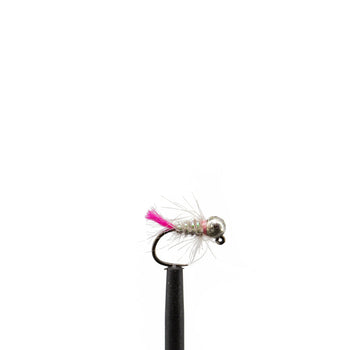
|
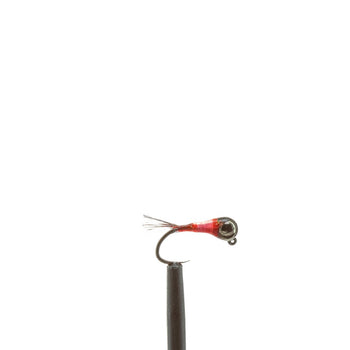
|

|
| Tungsten Bead Blowtorch Jig - Pink | Tungsten Bead Mr. Pink Jig | Pink Scud |

|
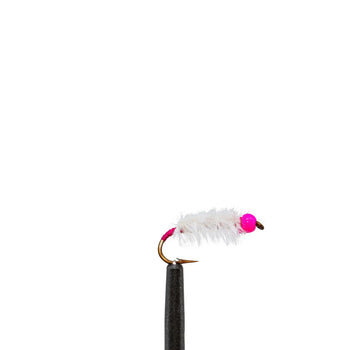
|

|
| Hot Head Stevie Wonder - Pink | Hot Head Ray Charles - Pink | Tungsten Bead Duracell Jig – Coppertop |
Tungsten Bead Blowtorch Jig - Pink (size 14–16): A Euro-style nymph with a tungsten bead and bright pink collar that triggers aggressive eats.
- How to Fish: Ideal for Euro nymphing in pocket water or tight-line setups near structure.
Tungsten Bead Mr. Pink Jig (size 14–16): A deep-diving jig nymph with a slim profile and fluorescent pink thorax. Deadly in fast or pocket water.
- How to Fish: Euro nymph it along seams or run it as an anchor fly in high flows.
Pink Scud (size 14–18): A spring creek and tailwater staple. The pink mimics dead or molting freshwater shrimp that trout love.
- How to Fish: Fish it slow near the bottom or as a dropper under a buoyant dry like a Humpy.
Hot Head Stevie Wonder - Pink (size 14–16): A soft-bodied pattern with lifelike movement and a fluorescent bead head for added pop.
- How to Fish: Fish it near spawning beds or trailing behind a larger nymph on a tandem rig.
Hot Head Ray Charles - Pink (size 16–18): A must-have for tailwaters, imitating sowbugs or scuds. Works especially well post-spawn or on pressured fish.
- How to Fish: Drift through feeding lanes or tailouts where trout are keying on spring invertebrates.
Tungsten Bead Duracell Jig - Coppertop (size 14–16): A compact Euro nymph with a copper bead, CDC collar, and slim profile for quick sink and subtle movement. Ideal for pressured trout in clear water or fast current.
-
How to Fish: Euro nymph near the bottom or use as an anchor fly in a two-fly rig with a natural dropper.
📌 Pro Tip: Pink nymphs are highly effective as anchor flies in two-fly rigs. Pair them with a more natural dropper like a Pheasant Tail, or use them on point for spring Euro setups. Vary your depth often—trout may shift feeding lanes throughout the day. Pink nymphs are highly effective as anchor flies in two-fly rigs. Pair them with a more natural dropper like a Pheasant Tail, or use them on point for spring Euro setups. Vary your depth often—trout may shift feeding lanes throughout the day.
Pink Dry Flies
Dry flies in pink may not imitate a specific hatch, but that’s exactly why they work. They’re high-visibility attractors that stand out in broken water, shine during variable light, and pull fish up when nothing else will. Whether you’re prospecting riffles or running a dry-dropper rig, these flies offer a great mix of floatation, visibility, and confidence. And when trout are sipping Baetis or midges near the surface? The smaller pink dries still get looks.

|

|
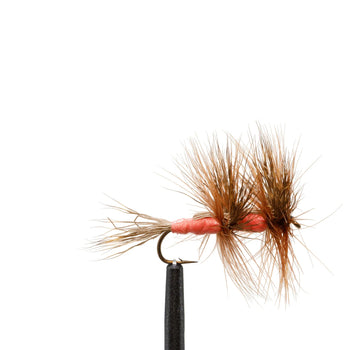
|
| Pink Sparkle Dun | Pink Lady | Pink Double Humpy |
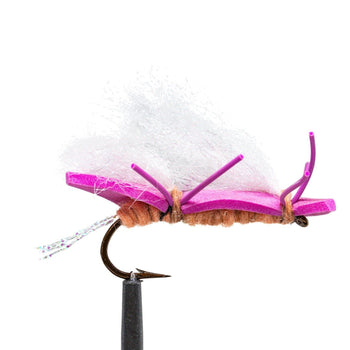
|
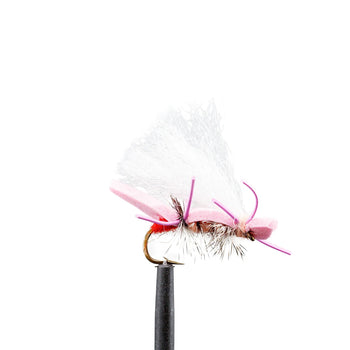
|
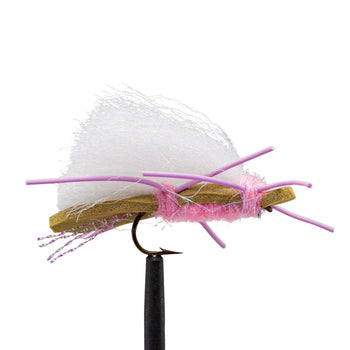
|
| Pink Chubby Chernobyl (Miss Piggy) | Miss Piggy Micro Chubby – Pink | Tan / Pink Chubby Chernobyl (The Karen) |
Pink Sparkle Dun (size 16–18): A delicate mayfly imitation with a hint of pink for extra visibility. Ideal for matching BWO hatches with a subtle attractor twist.
- How to Fish: Dead-drift over rising trout or in slow seams during spring Baetis activity.
Pink Lady (size 10–14): An old-school wet/dry hybrid with classic salmon styling. It draws curious looks on spring creeks and slow tailouts.
- How to Fish: Use on swing setups or skate it across the surface in low light conditions.
Pink Double Humpy (size 10–14): A beefier take on the classic Humpy with added flotation. Excellent visibility in glare or broken water.
- How to Fish: Fish solo or as a lead fly above a small midge emerger or nymph.
Pink Chubby Chernobyl - "Miss Piggy" (size 8–12): A big-bodied foam attractor with great floatation and visibility. Excellent for dry-dropper rigs in turbulent water.
- How to Fish: Fish it solo or use it to suspend heavier tungsten bead droppers in pocket water.
Miss Piggy Micro Chubby – Pink (size 14–16): A downsized version of the classic Chubby, this pattern is ideal for clear water, slower flows, or when trout are showing caution. It still rides high thanks to its foam body but offers a more subtle footprint.
- How to Fish: Fish solo in slick runs or use to suspend smaller nymphs on technical spring creeks.
Tan / Pink Chubby Chernobyl - "The Karen" (size 8–12): A subtle twist on the classic with a two-tone body and hi-vis post. Excels as an indicator fly when visibility is tough.
- How to Fish: Cast along banks and seams, or use to suspend a nymph rig in fast-moving water.
📌 Pro Tip: Bright pink dries like the Humpy or Chubby are perfect strike indicators on dry-dropper rigs. In early spring, use them to suspend smaller pink beadhead nymphs or soft hackles 12–24” below.** Bright pink dries like the Humpy or Chubby are perfect strike indicators on dry-dropper rigs. In early spring, use them to suspend smaller pink beadhead nymphs or soft hackles 12–24” below.
Pink Streamers & Leeches
When flows are high and the water turns off-color, it’s time to switch to streamers. These pink-tinted patterns imitate leeches, baitfish, or just something worth chasing. Their movement and silhouette provoke territorial strikes, while the pink accents help them stand out in deep, murky water. From slow swings to sharp strips, these are the flies to throw when you're targeting aggressive fish or trying to wake up sluggish ones.
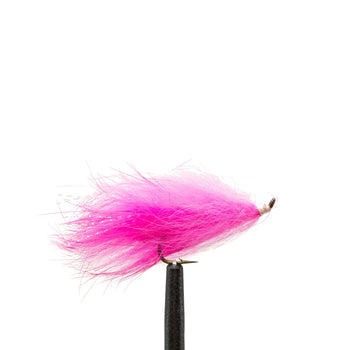
|

|

|
| Pink Bunny Leech | Purple Egg-Sucking Leech - Pink Egg | Pink Strip Leech |
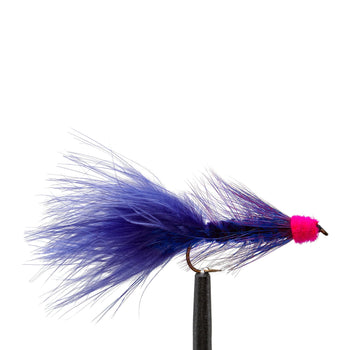
|
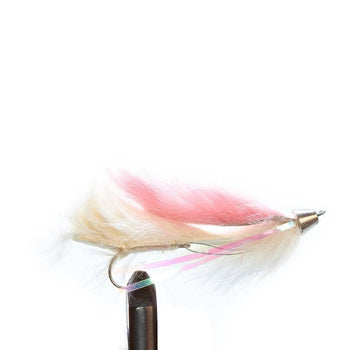
|

|
| Purple Egg-Sucking Leech - Cherise Egg | Dolly Llama - Pink / White | Phantom Leech Purple/ Pink |
Pink Bunny Leech (size 6–8): Classic rabbit strip construction gives this fly lifelike movement with a bold silhouette.
- How to Fish: Strip slowly along banks or dead-drift it on the swing through deep runs.
Purple Egg-Sucking Leech - Pink Egg (size 4–6): A bold, high-contrast streamer pattern that draws strikes from aggressive trout and steelhead. The pink egg head acts as a strong trigger in early spring.
- How to Fish: Swing it through tailouts, strip along banks, or dead-drift through deeper troughs.
Pink Strip Leech (size 6–8): A simple but effective leech pattern that excels in lakes or rivers with steady flows.
- How to Fish: Retrieve with slow, steady strips or let it hover below an indicator in stillwater.
Purple Egg-Sucking Leech - Cherise Egg (size 4–6): A vibrant variation of the classic ESL. The purple body provides dark contrast while the bright cherise egg triggers reflex strikes from trout and steelhead alike.
- How to Fish: Swing slowly through tailouts or strip with short pauses along drop-offs. Ideal in stained water or after a cold snap when fish are sluggish but reactive to color contrast.
Dolly Llama - Pink / White (size 2–6): A big-water favorite with tons of motion and size. Great for steelhead, rainbows, and aggressive browns.
- How to Fish: Cast downstream and across, then swing it with occasional twitches or strip it through tailouts.
Phantom Leech - Purple/Pink (size 6–8): This slender, soft-bodied leech pattern pulses with movement and blends subtle purple with a pink accent to trigger reflex strikes. Ideal for slow-moving or pressured spring trout.
- How to Fish: Fish on a slow strip, swing through deep seams, or dead-drift under an indicator near structure.
📌 Pro Tip: In cold spring water, slow down your retrieve. Twitchy or erratic strips often trigger aggression, but trout won’t chase far early in the season. Let the rabbit fur and articulation do the work.. Twitchy or erratic strips often trigger aggression, but trout won’t chase far early in the season. Let the rabbit fur and articulation do the work.
Bonus: Swing-Worthy Wildcards
Some flies don’t fit neatly into a single category—and that’s exactly what makes them special. These patterns blur the lines between nymphs, streamers, and emergers. Whether you’re swinging soft hackles just under the surface or probing deep seams with a buggy hybrid, these wildcards give you the flexibility to match the moment—especially when trout are holding mid-column or shifting feeding zones throughout the day.
MT Soft Hackle – Pink (size 14–16): A classic soft hackle with a modern twist. The subtle pink body adds visibility and attraction without spooking picky trout, making it deadly during midge and mayfly emergence windows.
- How to Fish: Swing through riffles and tailouts, or pair behind a dry fly as a dropper when trout are suspended near the surface.
Spring Wiggler – Pink (size 6–8): A hybrid between a worm and a streamer, with just enough weight and motion to imitate a struggling invertebrate. It shines when the water is off-color and fish are tucked near the bottom.
- How to Fish: Fish it deep under an indicator or swing slowly through slower buckets and seams.
📌 Pro Tip: These patterns thrive in transition water—seams, tailouts, and the edges of riffles. Use them when fish aren't fully on top or hugging the bottom. A downstream swing or a soft lift at the end of your drift often triggers aggressive eats.
Conclusion: Don’t Overlook Pink
Across dries, nymphs, streamers, and everything in between, pink fly patterns have carved out a permanent home in the spring fly box—and for good reason. Pink not only stands out in murky water and low light, but it also mimics high-value food sources like eggs, scuds, and worms that dominate early-season drifts.
The beauty of pink is its versatility. It’s equally at home suspended under a Chubby, bounced through a riffle Euro-style, or swung softly just below the surface. When trout are moody or selective, a bold color choice like pink can break the pattern and trigger a response.
If you’re heading out this spring and want a little extra confidence in your box, trust the pink. It's not just a color—it’s a strategy.
It may not look like much in the vise, but in the water, pink becomes a signal trout can't resist.


